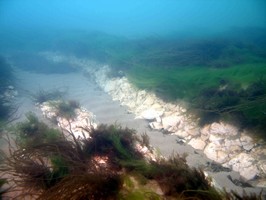 Divers have discovered the WORLD’S LONGEST underwater chalk reef – off the coast of NORFOLK.
Divers have discovered the WORLD’S LONGEST underwater chalk reef – off the coast of NORFOLK.
The incredible 20 MILE chalk reef, which is teaming with colourful fish, plants and wildlife, has remained hidden under the North Sea for 300 million years.
The amazing natural phenomenon, which lies just half a mile from the shore, features massive two-metre high rock arches and deep gullies where the water has worn away the chalk.
The team of amateur volunteer divers came across the remarkable rocky plain – a mere eight metres under the sea - when they were surveying the area.
It is one-and-a-half times LONGER than the Thanet Coast chalk reefs in Kent, which are 14 miles long and were previously recorded as the longest in the world.
“It is an absolutely fantastic find for us,” said diver Rob Spray, 43, who runs the Marine Conservation Society’s survey project, Seasearch in East Anglia.
“The reef has been created naturally over millions of years and remained almost untouched until now.
“We knew there was some sort of chalk reef under the sea but we thought it probably only stretched around five miles.
“We couldn’t believe it when we found it was actually 20 miles long and had this amazing complex of gullies and arches.
“In some areas it looks like a moonscape with miles of smooth white chalk, where it has been polished and cleaned by the rocks, sand and gravel.”
Rob, who has been diving in the North Sea with partner Dawn Watson, 41, for 12 years, knew there was a chalk area off the east coast but had always believed it was fairly small. He approached Norfolk County Council for funds to carry out a proper survey of the reef earlier this year and in July his team of 20 volunteers started mapping the site. The team spent three months working on the project using a very small inflatable boat and diving in strong currents to cover a greater stretch of seabed. To their astonishment they discovered the reef stretched along the North Norfolk coast from Cley next the Sea to Trimingham, which is 20 miles away.
“We thought it would be a small project, but on the very first day we started five miles west of where we though the reef was and discovered chalk,” he said.
“So after our first dive we had already doubled the size of the known reef and every time we went back we found more and more.
“We were also stunned to see it had so many significant features, such as the man high rock arches. I found one then suddenly discovered a whole row.
“It was like finding a natural Stonehenge hidden underneath the water.
“It reminds me of reefs I have seen in Malta and I never expected to find anything on this scale in Norfolk.”
The reef is incredibly rich in wildlife, including sponges, sea slugs and fish, and the divers have already found three species which had never before been recorded on the East Anglian coast. These are the Leopard Spotted Goby, two rare anemones – the Strawberry Anemone and Ancula gibbosa and an obscure new sponge.
“The chalk reefs are fantastic for wildlife and are teaming with shoals of reef-loving fish, coated with anemones and hosting characters such as the Tompot blenny,” he said.
“Animals and plants can live in sand and gravel but they are hostile environments and rocky reefs are much better as they enable creatures to get up into the water column to feed.”
The divers have now reported their findings to the Marine Conservation Zone project and hope the reef will be made into a protected reserve under European law.
They also plan to continue their survey next year to find out how wide the reef is, so they can work out its total area.
“The white chalk gives this reef a really unique character and we hope people will now come to Norfolk to see it for themselves,” he said.
“Norfolk is an easy place to dive and you can walk just 100 metres out from the coast and be on the reef.
“I think the reef will really benefit tourism in the county and we hope it will officially be made into a reserve as it has no real protection at the moment.”
Tim Venes, manager for the Norfolk Coast Partnership, said: “The chalk gullies, just off the coast near Sheringham, provide a little known additional dimension to the wide variety of very special habitats found along the Norfolk coast, with beauty and colour in their plants and animals that rivals reefs in much warmer waters.
“As they become better known and number of dives in the area increase, it is even more important for people to remember that this delicate environment needs our protection and respect in order to ensure its continued survival.”
Lydia Smith, director of Norfolk Tourism, added: “It is wonderful news that this 20-mile long chalk reef has been discovered just off the North Norfolk Coast.
“The photographs are beautiful. The chalk reef combined with our coastal nature reserves will add to North Norfolk’s reputation as a wildlife destination, but the fragility of the environment means that its conservation and protection will be paramount.”
Although less than one per cent of the UK coastline is chalk, the UK has 75 per cent of the chalk reefs in Europe. The Great Barrier Reef in Australia is the largest reef in the world stretching over 1800 miles. There are a handful of cold water coral reefs around Britain, including one off Rockall, an isolated island 200 miles off Scotland.






